Customer Perceived Quality and Brand Loyalty
VerifiedAdded on 2020/01/07
|15
|4502
|153
Literature Review
AI Summary
The provided content examines various studies on customer loyalty, focusing on factors such as perceived quality, perceived value, expectations, and satisfaction. The studies cover different contexts, including sportswear (Globe Trotter), social media marketing, mobile telecommunication industry, automobile sector, and brand communities. Overall, the findings suggest that customer satisfaction, trust, and perceived value are crucial in building brand loyalty.
Contribute Materials
Your contribution can guide someone’s learning journey. Share your
documents today.
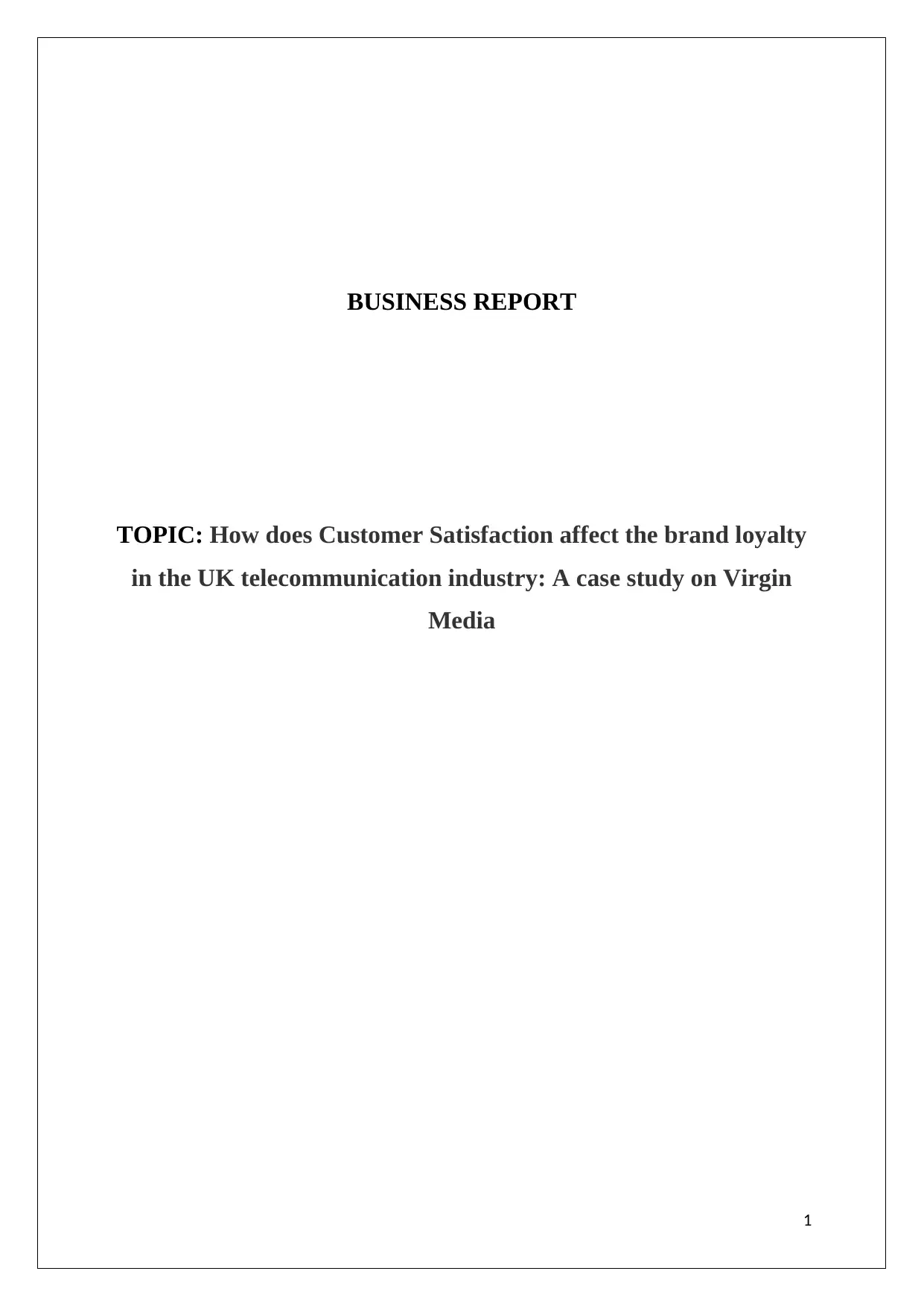
BUSINESS REPORT
TOPIC: How does Customer Satisfaction affect the brand loyalty
in the UK telecommunication industry: A case study on Virgin
Media
1
TOPIC: How does Customer Satisfaction affect the brand loyalty
in the UK telecommunication industry: A case study on Virgin
Media
1
Secure Best Marks with AI Grader
Need help grading? Try our AI Grader for instant feedback on your assignments.
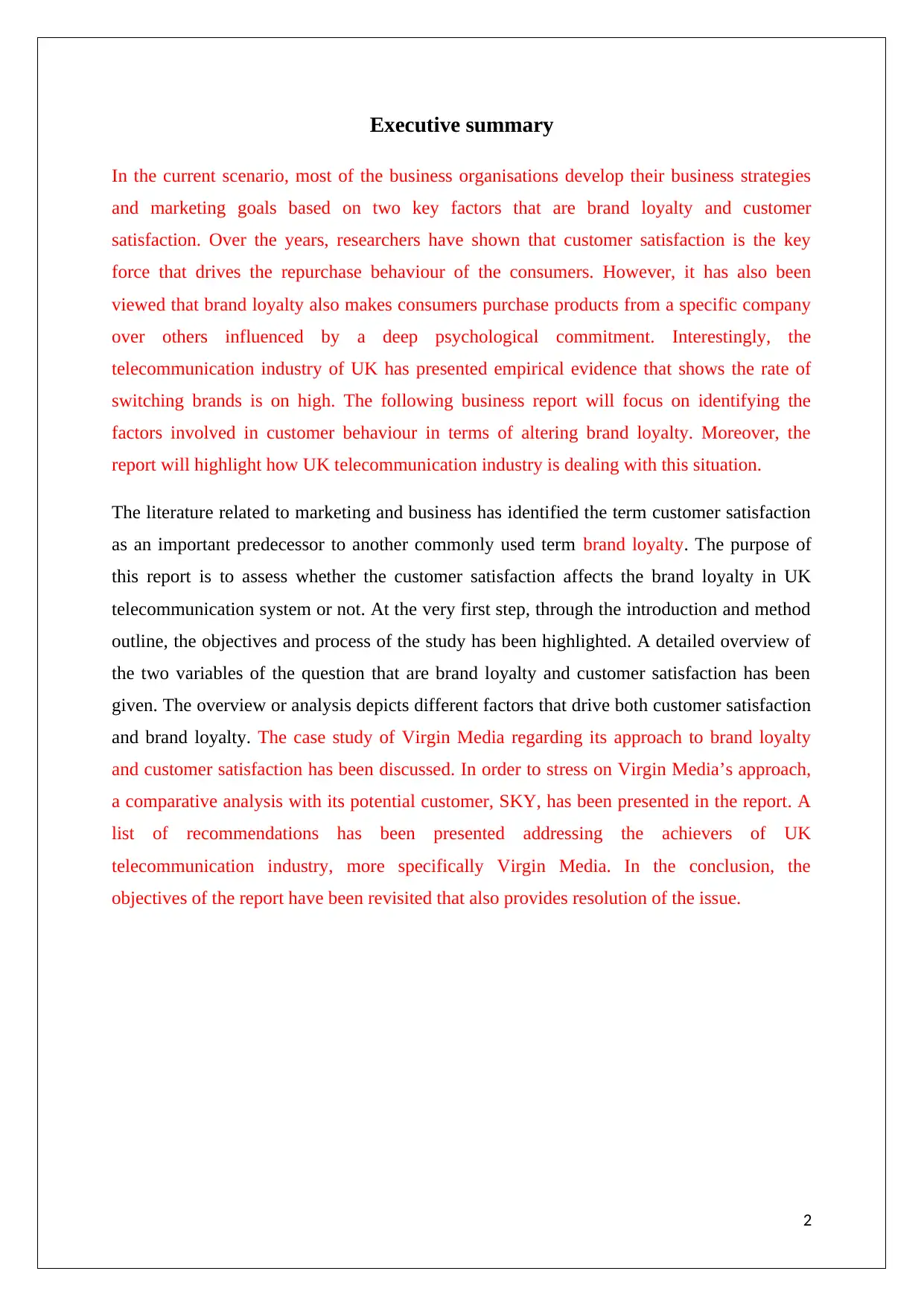
Executive summary
In the current scenario, most of the business organisations develop their business strategies
and marketing goals based on two key factors that are brand loyalty and customer
satisfaction. Over the years, researchers have shown that customer satisfaction is the key
force that drives the repurchase behaviour of the consumers. However, it has also been
viewed that brand loyalty also makes consumers purchase products from a specific company
over others influenced by a deep psychological commitment. Interestingly, the
telecommunication industry of UK has presented empirical evidence that shows the rate of
switching brands is on high. The following business report will focus on identifying the
factors involved in customer behaviour in terms of altering brand loyalty. Moreover, the
report will highlight how UK telecommunication industry is dealing with this situation.
The literature related to marketing and business has identified the term customer satisfaction
as an important predecessor to another commonly used term brand loyalty. The purpose of
this report is to assess whether the customer satisfaction affects the brand loyalty in UK
telecommunication system or not. At the very first step, through the introduction and method
outline, the objectives and process of the study has been highlighted. A detailed overview of
the two variables of the question that are brand loyalty and customer satisfaction has been
given. The overview or analysis depicts different factors that drive both customer satisfaction
and brand loyalty. The case study of Virgin Media regarding its approach to brand loyalty
and customer satisfaction has been discussed. In order to stress on Virgin Media’s approach,
a comparative analysis with its potential customer, SKY, has been presented in the report. A
list of recommendations has been presented addressing the achievers of UK
telecommunication industry, more specifically Virgin Media. In the conclusion, the
objectives of the report have been revisited that also provides resolution of the issue.
2
In the current scenario, most of the business organisations develop their business strategies
and marketing goals based on two key factors that are brand loyalty and customer
satisfaction. Over the years, researchers have shown that customer satisfaction is the key
force that drives the repurchase behaviour of the consumers. However, it has also been
viewed that brand loyalty also makes consumers purchase products from a specific company
over others influenced by a deep psychological commitment. Interestingly, the
telecommunication industry of UK has presented empirical evidence that shows the rate of
switching brands is on high. The following business report will focus on identifying the
factors involved in customer behaviour in terms of altering brand loyalty. Moreover, the
report will highlight how UK telecommunication industry is dealing with this situation.
The literature related to marketing and business has identified the term customer satisfaction
as an important predecessor to another commonly used term brand loyalty. The purpose of
this report is to assess whether the customer satisfaction affects the brand loyalty in UK
telecommunication system or not. At the very first step, through the introduction and method
outline, the objectives and process of the study has been highlighted. A detailed overview of
the two variables of the question that are brand loyalty and customer satisfaction has been
given. The overview or analysis depicts different factors that drive both customer satisfaction
and brand loyalty. The case study of Virgin Media regarding its approach to brand loyalty
and customer satisfaction has been discussed. In order to stress on Virgin Media’s approach,
a comparative analysis with its potential customer, SKY, has been presented in the report. A
list of recommendations has been presented addressing the achievers of UK
telecommunication industry, more specifically Virgin Media. In the conclusion, the
objectives of the report have been revisited that also provides resolution of the issue.
2
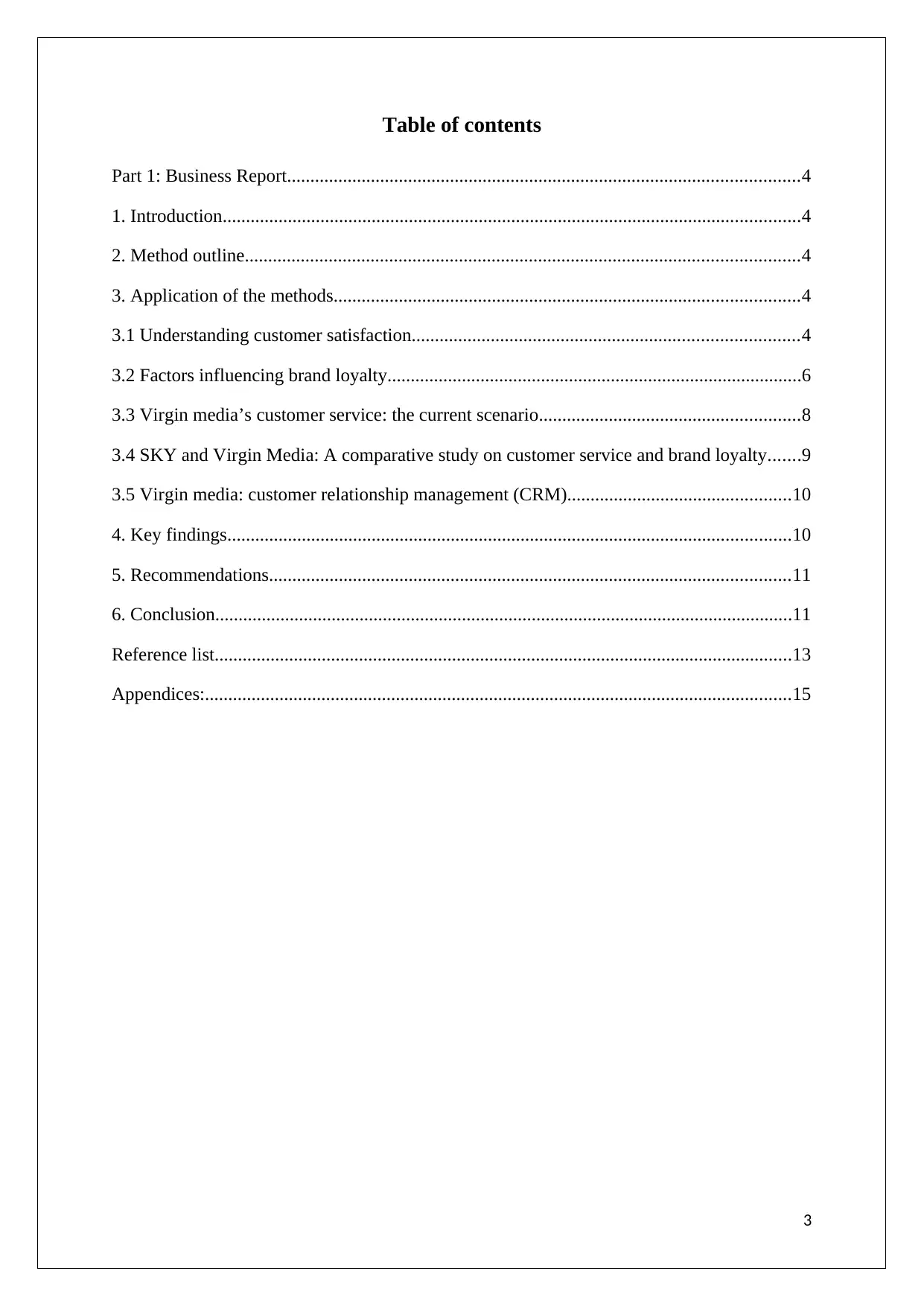
Table of contents
Part 1: Business Report..............................................................................................................4
1. Introduction............................................................................................................................4
2. Method outline.......................................................................................................................4
3. Application of the methods....................................................................................................4
3.1 Understanding customer satisfaction...................................................................................4
3.2 Factors influencing brand loyalty.........................................................................................6
3.3 Virgin media’s customer service: the current scenario........................................................8
3.4 SKY and Virgin Media: A comparative study on customer service and brand loyalty.......9
3.5 Virgin media: customer relationship management (CRM)................................................10
4. Key findings.........................................................................................................................10
5. Recommendations................................................................................................................11
6. Conclusion............................................................................................................................11
Reference list............................................................................................................................13
Appendices:..............................................................................................................................15
3
Part 1: Business Report..............................................................................................................4
1. Introduction............................................................................................................................4
2. Method outline.......................................................................................................................4
3. Application of the methods....................................................................................................4
3.1 Understanding customer satisfaction...................................................................................4
3.2 Factors influencing brand loyalty.........................................................................................6
3.3 Virgin media’s customer service: the current scenario........................................................8
3.4 SKY and Virgin Media: A comparative study on customer service and brand loyalty.......9
3.5 Virgin media: customer relationship management (CRM)................................................10
4. Key findings.........................................................................................................................10
5. Recommendations................................................................................................................11
6. Conclusion............................................................................................................................11
Reference list............................................................................................................................13
Appendices:..............................................................................................................................15
3
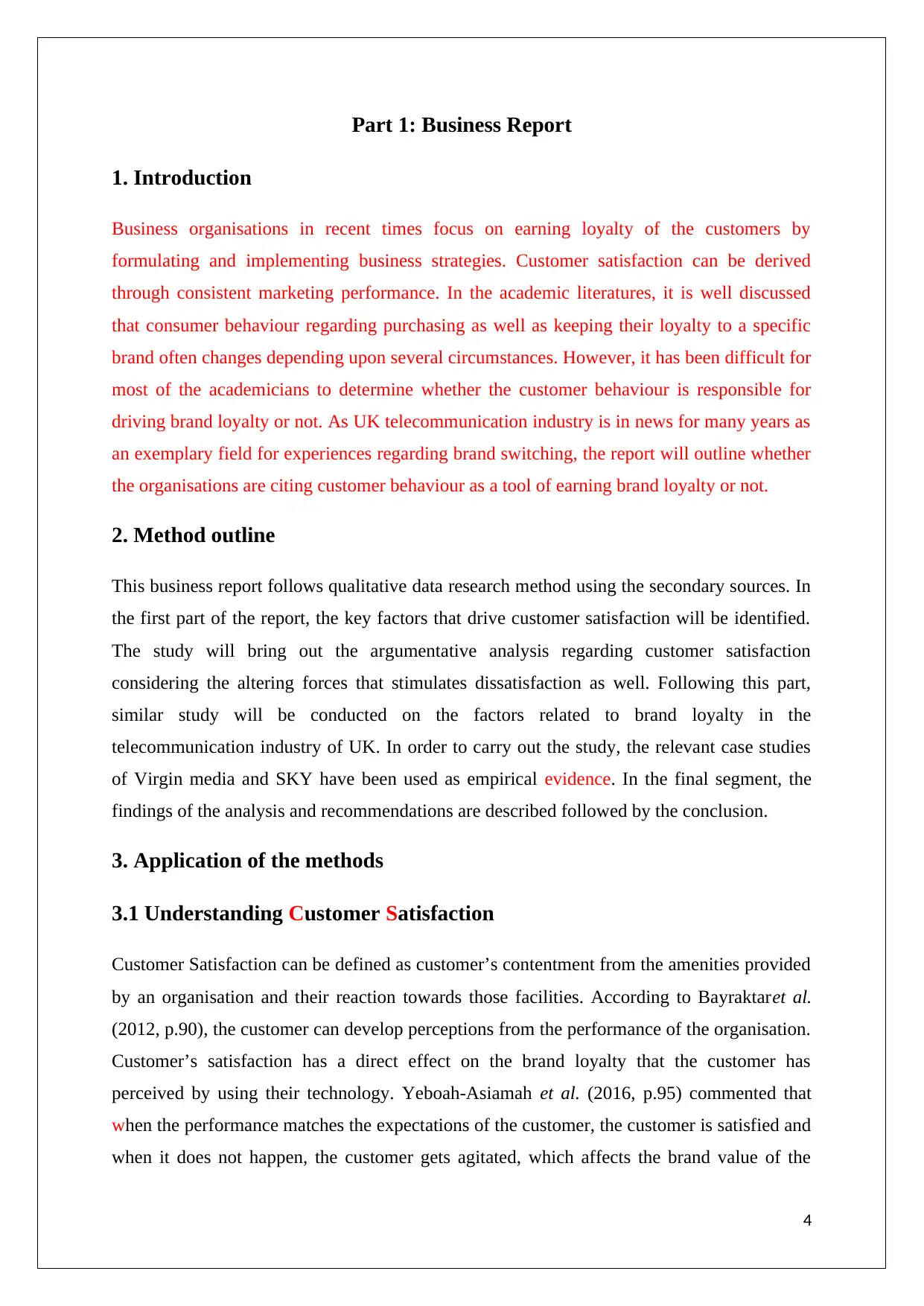
Part 1: Business Report
1. Introduction
Business organisations in recent times focus on earning loyalty of the customers by
formulating and implementing business strategies. Customer satisfaction can be derived
through consistent marketing performance. In the academic literatures, it is well discussed
that consumer behaviour regarding purchasing as well as keeping their loyalty to a specific
brand often changes depending upon several circumstances. However, it has been difficult for
most of the academicians to determine whether the customer behaviour is responsible for
driving brand loyalty or not. As UK telecommunication industry is in news for many years as
an exemplary field for experiences regarding brand switching, the report will outline whether
the organisations are citing customer behaviour as a tool of earning brand loyalty or not.
2. Method outline
This business report follows qualitative data research method using the secondary sources. In
the first part of the report, the key factors that drive customer satisfaction will be identified.
The study will bring out the argumentative analysis regarding customer satisfaction
considering the altering forces that stimulates dissatisfaction as well. Following this part,
similar study will be conducted on the factors related to brand loyalty in the
telecommunication industry of UK. In order to carry out the study, the relevant case studies
of Virgin media and SKY have been used as empirical evidence. In the final segment, the
findings of the analysis and recommendations are described followed by the conclusion.
3. Application of the methods
3.1 Understanding Customer Satisfaction
Customer Satisfaction can be defined as customer’s contentment from the amenities provided
by an organisation and their reaction towards those facilities. According to Bayraktaret al.
(2012, p.90), the customer can develop perceptions from the performance of the organisation.
Customer’s satisfaction has a direct effect on the brand loyalty that the customer has
perceived by using their technology. Yeboah-Asiamah et al. (2016, p.95) commented that
when the performance matches the expectations of the customer, the customer is satisfied and
when it does not happen, the customer gets agitated, which affects the brand value of the
4
1. Introduction
Business organisations in recent times focus on earning loyalty of the customers by
formulating and implementing business strategies. Customer satisfaction can be derived
through consistent marketing performance. In the academic literatures, it is well discussed
that consumer behaviour regarding purchasing as well as keeping their loyalty to a specific
brand often changes depending upon several circumstances. However, it has been difficult for
most of the academicians to determine whether the customer behaviour is responsible for
driving brand loyalty or not. As UK telecommunication industry is in news for many years as
an exemplary field for experiences regarding brand switching, the report will outline whether
the organisations are citing customer behaviour as a tool of earning brand loyalty or not.
2. Method outline
This business report follows qualitative data research method using the secondary sources. In
the first part of the report, the key factors that drive customer satisfaction will be identified.
The study will bring out the argumentative analysis regarding customer satisfaction
considering the altering forces that stimulates dissatisfaction as well. Following this part,
similar study will be conducted on the factors related to brand loyalty in the
telecommunication industry of UK. In order to carry out the study, the relevant case studies
of Virgin media and SKY have been used as empirical evidence. In the final segment, the
findings of the analysis and recommendations are described followed by the conclusion.
3. Application of the methods
3.1 Understanding Customer Satisfaction
Customer Satisfaction can be defined as customer’s contentment from the amenities provided
by an organisation and their reaction towards those facilities. According to Bayraktaret al.
(2012, p.90), the customer can develop perceptions from the performance of the organisation.
Customer’s satisfaction has a direct effect on the brand loyalty that the customer has
perceived by using their technology. Yeboah-Asiamah et al. (2016, p.95) commented that
when the performance matches the expectations of the customer, the customer is satisfied and
when it does not happen, the customer gets agitated, which affects the brand value of the
4
Secure Best Marks with AI Grader
Need help grading? Try our AI Grader for instant feedback on your assignments.
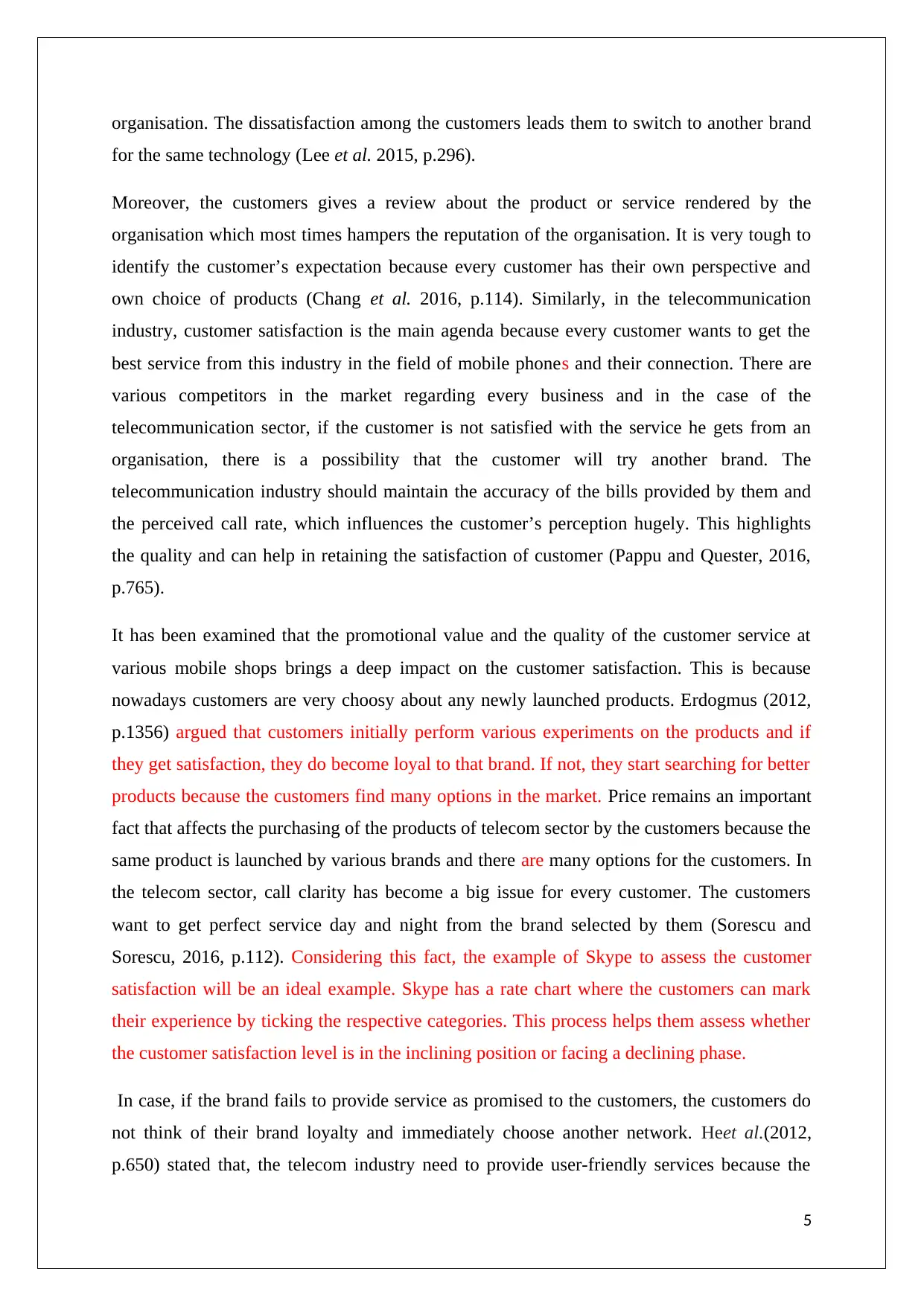
organisation. The dissatisfaction among the customers leads them to switch to another brand
for the same technology (Lee et al. 2015, p.296).
Moreover, the customers gives a review about the product or service rendered by the
organisation which most times hampers the reputation of the organisation. It is very tough to
identify the customer’s expectation because every customer has their own perspective and
own choice of products (Chang et al. 2016, p.114). Similarly, in the telecommunication
industry, customer satisfaction is the main agenda because every customer wants to get the
best service from this industry in the field of mobile phones and their connection. There are
various competitors in the market regarding every business and in the case of the
telecommunication sector, if the customer is not satisfied with the service he gets from an
organisation, there is a possibility that the customer will try another brand. The
telecommunication industry should maintain the accuracy of the bills provided by them and
the perceived call rate, which influences the customer’s perception hugely. This highlights
the quality and can help in retaining the satisfaction of customer (Pappu and Quester, 2016,
p.765).
It has been examined that the promotional value and the quality of the customer service at
various mobile shops brings a deep impact on the customer satisfaction. This is because
nowadays customers are very choosy about any newly launched products. Erdogmus (2012,
p.1356) argued that customers initially perform various experiments on the products and if
they get satisfaction, they do become loyal to that brand. If not, they start searching for better
products because the customers find many options in the market. Price remains an important
fact that affects the purchasing of the products of telecom sector by the customers because the
same product is launched by various brands and there are many options for the customers. In
the telecom sector, call clarity has become a big issue for every customer. The customers
want to get perfect service day and night from the brand selected by them (Sorescu and
Sorescu, 2016, p.112). Considering this fact, the example of Skype to assess the customer
satisfaction will be an ideal example. Skype has a rate chart where the customers can mark
their experience by ticking the respective categories. This process helps them assess whether
the customer satisfaction level is in the inclining position or facing a declining phase.
In case, if the brand fails to provide service as promised to the customers, the customers do
not think of their brand loyalty and immediately choose another network. Heet al.(2012,
p.650) stated that, the telecom industry need to provide user-friendly services because the
5
for the same technology (Lee et al. 2015, p.296).
Moreover, the customers gives a review about the product or service rendered by the
organisation which most times hampers the reputation of the organisation. It is very tough to
identify the customer’s expectation because every customer has their own perspective and
own choice of products (Chang et al. 2016, p.114). Similarly, in the telecommunication
industry, customer satisfaction is the main agenda because every customer wants to get the
best service from this industry in the field of mobile phones and their connection. There are
various competitors in the market regarding every business and in the case of the
telecommunication sector, if the customer is not satisfied with the service he gets from an
organisation, there is a possibility that the customer will try another brand. The
telecommunication industry should maintain the accuracy of the bills provided by them and
the perceived call rate, which influences the customer’s perception hugely. This highlights
the quality and can help in retaining the satisfaction of customer (Pappu and Quester, 2016,
p.765).
It has been examined that the promotional value and the quality of the customer service at
various mobile shops brings a deep impact on the customer satisfaction. This is because
nowadays customers are very choosy about any newly launched products. Erdogmus (2012,
p.1356) argued that customers initially perform various experiments on the products and if
they get satisfaction, they do become loyal to that brand. If not, they start searching for better
products because the customers find many options in the market. Price remains an important
fact that affects the purchasing of the products of telecom sector by the customers because the
same product is launched by various brands and there are many options for the customers. In
the telecom sector, call clarity has become a big issue for every customer. The customers
want to get perfect service day and night from the brand selected by them (Sorescu and
Sorescu, 2016, p.112). Considering this fact, the example of Skype to assess the customer
satisfaction will be an ideal example. Skype has a rate chart where the customers can mark
their experience by ticking the respective categories. This process helps them assess whether
the customer satisfaction level is in the inclining position or facing a declining phase.
In case, if the brand fails to provide service as promised to the customers, the customers do
not think of their brand loyalty and immediately choose another network. Heet al.(2012,
p.650) stated that, the telecom industry need to provide user-friendly services because the
5
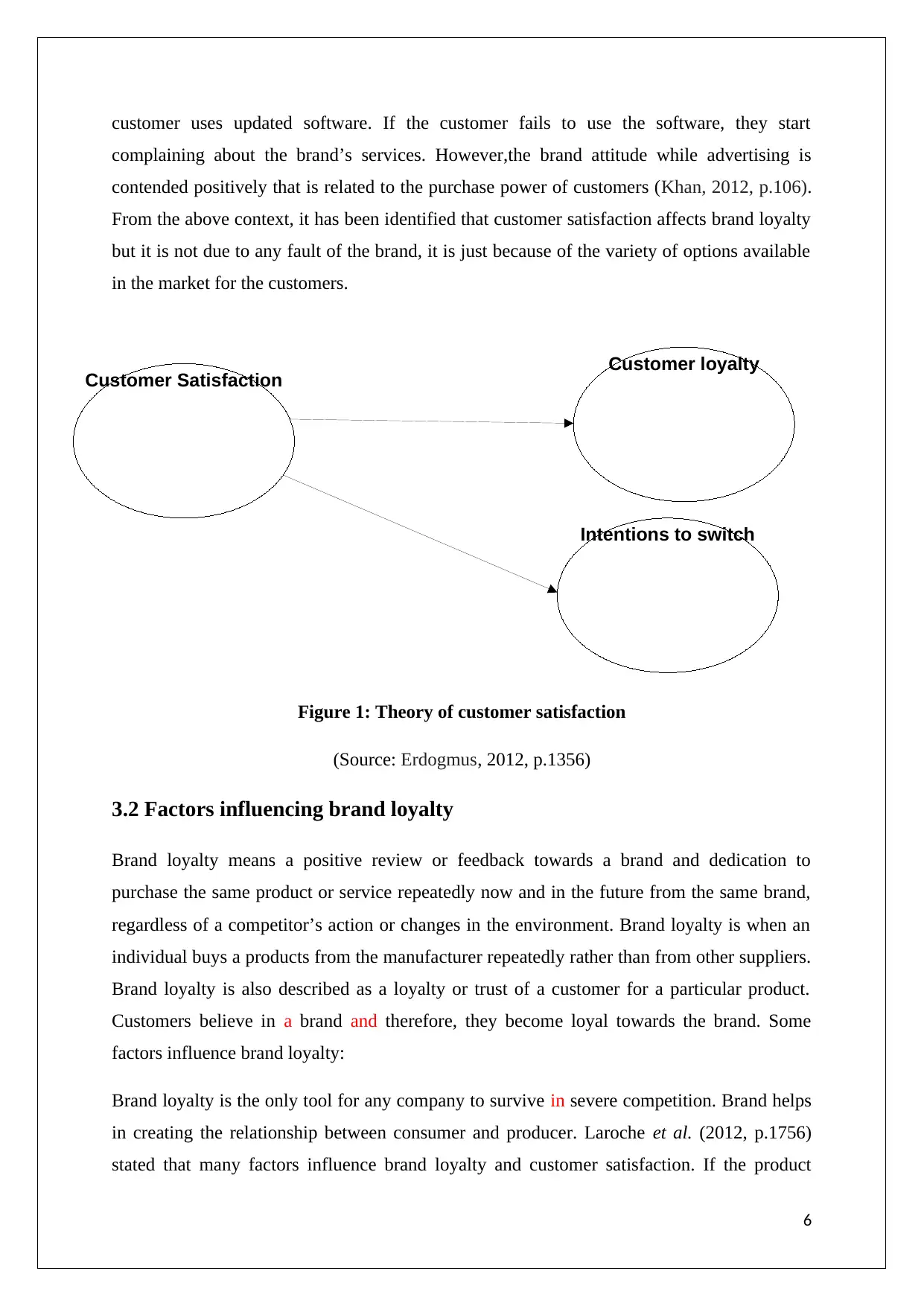
Customer Satisfaction
Intentions to switch
Customer loyalty
customer uses updated software. If the customer fails to use the software, they start
complaining about the brand’s services. However,the brand attitude while advertising is
contended positively that is related to the purchase power of customers (Khan, 2012, p.106).
From the above context, it has been identified that customer satisfaction affects brand loyalty
but it is not due to any fault of the brand, it is just because of the variety of options available
in the market for the customers.
Figure 1: Theory of customer satisfaction
(Source: Erdogmus, 2012, p.1356)
3.2 Factors influencing brand loyalty
Brand loyalty means a positive review or feedback towards a brand and dedication to
purchase the same product or service repeatedly now and in the future from the same brand,
regardless of a competitor’s action or changes in the environment. Brand loyalty is when an
individual buys a products from the manufacturer repeatedly rather than from other suppliers.
Brand loyalty is also described as a loyalty or trust of a customer for a particular product.
Customers believe in a brand and therefore, they become loyal towards the brand. Some
factors influence brand loyalty:
Brand loyalty is the only tool for any company to survive in severe competition. Brand helps
in creating the relationship between consumer and producer. Laroche et al. (2012, p.1756)
stated that many factors influence brand loyalty and customer satisfaction. If the product
6
Intentions to switch
Customer loyalty
customer uses updated software. If the customer fails to use the software, they start
complaining about the brand’s services. However,the brand attitude while advertising is
contended positively that is related to the purchase power of customers (Khan, 2012, p.106).
From the above context, it has been identified that customer satisfaction affects brand loyalty
but it is not due to any fault of the brand, it is just because of the variety of options available
in the market for the customers.
Figure 1: Theory of customer satisfaction
(Source: Erdogmus, 2012, p.1356)
3.2 Factors influencing brand loyalty
Brand loyalty means a positive review or feedback towards a brand and dedication to
purchase the same product or service repeatedly now and in the future from the same brand,
regardless of a competitor’s action or changes in the environment. Brand loyalty is when an
individual buys a products from the manufacturer repeatedly rather than from other suppliers.
Brand loyalty is also described as a loyalty or trust of a customer for a particular product.
Customers believe in a brand and therefore, they become loyal towards the brand. Some
factors influence brand loyalty:
Brand loyalty is the only tool for any company to survive in severe competition. Brand helps
in creating the relationship between consumer and producer. Laroche et al. (2012, p.1756)
stated that many factors influence brand loyalty and customer satisfaction. If the product
6
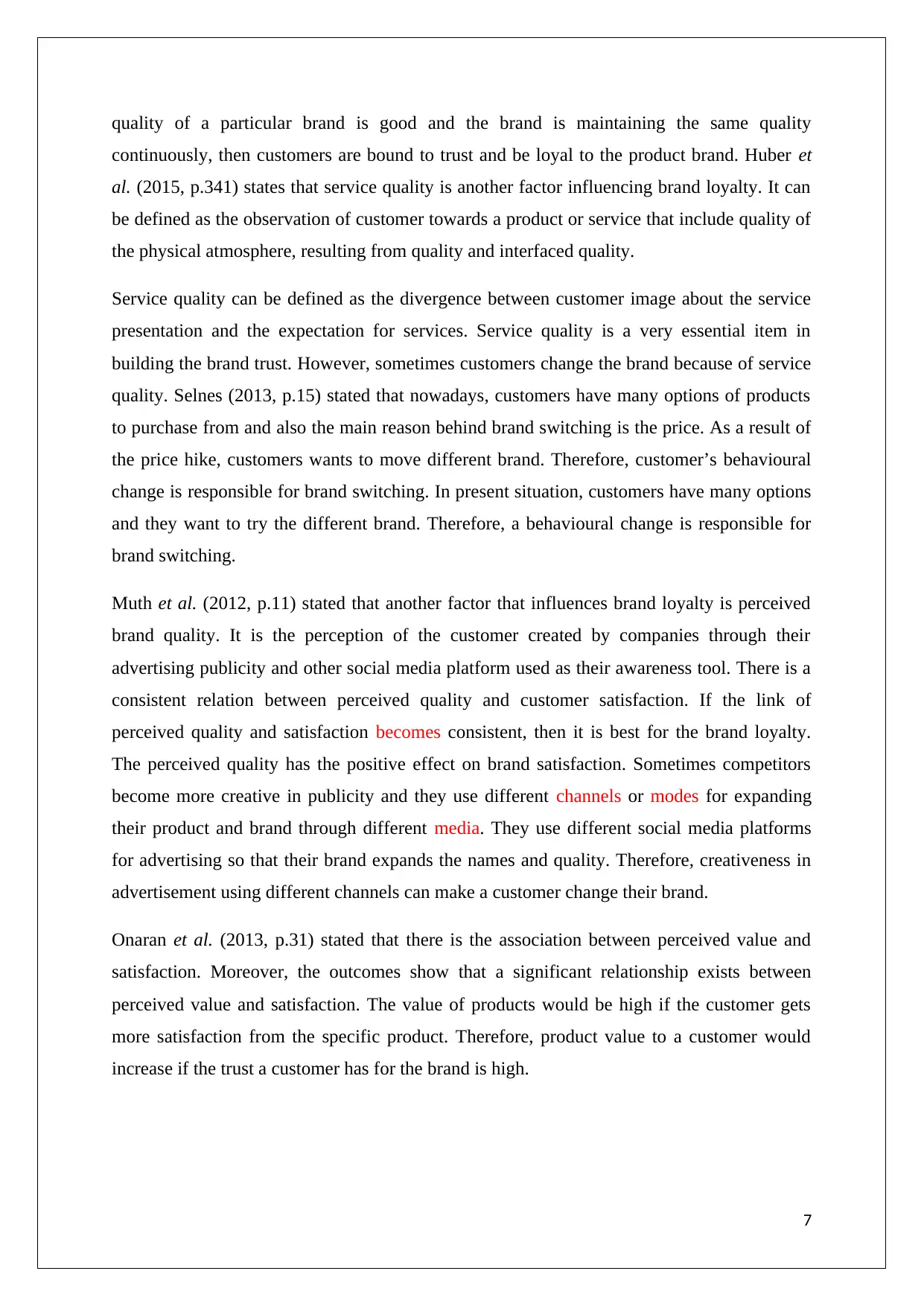
quality of a particular brand is good and the brand is maintaining the same quality
continuously, then customers are bound to trust and be loyal to the product brand. Huber et
al. (2015, p.341) states that service quality is another factor influencing brand loyalty. It can
be defined as the observation of customer towards a product or service that include quality of
the physical atmosphere, resulting from quality and interfaced quality.
Service quality can be defined as the divergence between customer image about the service
presentation and the expectation for services. Service quality is a very essential item in
building the brand trust. However, sometimes customers change the brand because of service
quality. Selnes (2013, p.15) stated that nowadays, customers have many options of products
to purchase from and also the main reason behind brand switching is the price. As a result of
the price hike, customers wants to move different brand. Therefore, customer’s behavioural
change is responsible for brand switching. In present situation, customers have many options
and they want to try the different brand. Therefore, a behavioural change is responsible for
brand switching.
Muth et al. (2012, p.11) stated that another factor that influences brand loyalty is perceived
brand quality. It is the perception of the customer created by companies through their
advertising publicity and other social media platform used as their awareness tool. There is a
consistent relation between perceived quality and customer satisfaction. If the link of
perceived quality and satisfaction becomes consistent, then it is best for the brand loyalty.
The perceived quality has the positive effect on brand satisfaction. Sometimes competitors
become more creative in publicity and they use different channels or modes for expanding
their product and brand through different media. They use different social media platforms
for advertising so that their brand expands the names and quality. Therefore, creativeness in
advertisement using different channels can make a customer change their brand.
Onaran et al. (2013, p.31) stated that there is the association between perceived value and
satisfaction. Moreover, the outcomes show that a significant relationship exists between
perceived value and satisfaction. The value of products would be high if the customer gets
more satisfaction from the specific product. Therefore, product value to a customer would
increase if the trust a customer has for the brand is high.
7
continuously, then customers are bound to trust and be loyal to the product brand. Huber et
al. (2015, p.341) states that service quality is another factor influencing brand loyalty. It can
be defined as the observation of customer towards a product or service that include quality of
the physical atmosphere, resulting from quality and interfaced quality.
Service quality can be defined as the divergence between customer image about the service
presentation and the expectation for services. Service quality is a very essential item in
building the brand trust. However, sometimes customers change the brand because of service
quality. Selnes (2013, p.15) stated that nowadays, customers have many options of products
to purchase from and also the main reason behind brand switching is the price. As a result of
the price hike, customers wants to move different brand. Therefore, customer’s behavioural
change is responsible for brand switching. In present situation, customers have many options
and they want to try the different brand. Therefore, a behavioural change is responsible for
brand switching.
Muth et al. (2012, p.11) stated that another factor that influences brand loyalty is perceived
brand quality. It is the perception of the customer created by companies through their
advertising publicity and other social media platform used as their awareness tool. There is a
consistent relation between perceived quality and customer satisfaction. If the link of
perceived quality and satisfaction becomes consistent, then it is best for the brand loyalty.
The perceived quality has the positive effect on brand satisfaction. Sometimes competitors
become more creative in publicity and they use different channels or modes for expanding
their product and brand through different media. They use different social media platforms
for advertising so that their brand expands the names and quality. Therefore, creativeness in
advertisement using different channels can make a customer change their brand.
Onaran et al. (2013, p.31) stated that there is the association between perceived value and
satisfaction. Moreover, the outcomes show that a significant relationship exists between
perceived value and satisfaction. The value of products would be high if the customer gets
more satisfaction from the specific product. Therefore, product value to a customer would
increase if the trust a customer has for the brand is high.
7
Paraphrase This Document
Need a fresh take? Get an instant paraphrase of this document with our AI Paraphraser
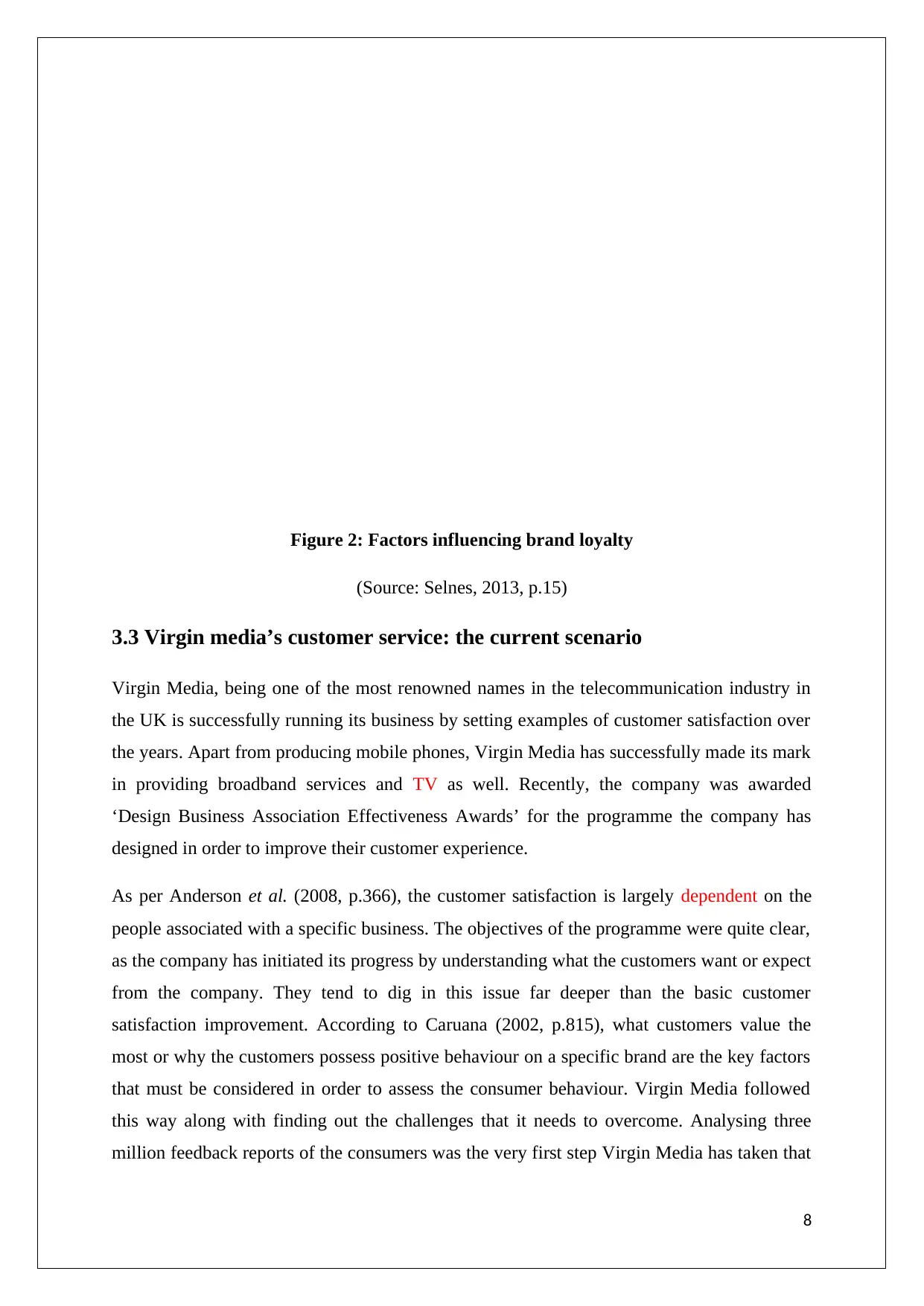
Figure 2: Factors influencing brand loyalty
(Source: Selnes, 2013, p.15)
3.3 Virgin media’s customer service: the current scenario
Virgin Media, being one of the most renowned names in the telecommunication industry in
the UK is successfully running its business by setting examples of customer satisfaction over
the years. Apart from producing mobile phones, Virgin Media has successfully made its mark
in providing broadband services and TV as well. Recently, the company was awarded
‘Design Business Association Effectiveness Awards’ for the programme the company has
designed in order to improve their customer experience.
As per Anderson et al. (2008, p.366), the customer satisfaction is largely dependent on the
people associated with a specific business. The objectives of the programme were quite clear,
as the company has initiated its progress by understanding what the customers want or expect
from the company. They tend to dig in this issue far deeper than the basic customer
satisfaction improvement. According to Caruana (2002, p.815), what customers value the
most or why the customers possess positive behaviour on a specific brand are the key factors
that must be considered in order to assess the consumer behaviour. Virgin Media followed
this way along with finding out the challenges that it needs to overcome. Analysing three
million feedback reports of the consumers was the very first step Virgin Media has taken that
8
(Source: Selnes, 2013, p.15)
3.3 Virgin media’s customer service: the current scenario
Virgin Media, being one of the most renowned names in the telecommunication industry in
the UK is successfully running its business by setting examples of customer satisfaction over
the years. Apart from producing mobile phones, Virgin Media has successfully made its mark
in providing broadband services and TV as well. Recently, the company was awarded
‘Design Business Association Effectiveness Awards’ for the programme the company has
designed in order to improve their customer experience.
As per Anderson et al. (2008, p.366), the customer satisfaction is largely dependent on the
people associated with a specific business. The objectives of the programme were quite clear,
as the company has initiated its progress by understanding what the customers want or expect
from the company. They tend to dig in this issue far deeper than the basic customer
satisfaction improvement. According to Caruana (2002, p.815), what customers value the
most or why the customers possess positive behaviour on a specific brand are the key factors
that must be considered in order to assess the consumer behaviour. Virgin Media followed
this way along with finding out the challenges that it needs to overcome. Analysing three
million feedback reports of the consumers was the very first step Virgin Media has taken that
8
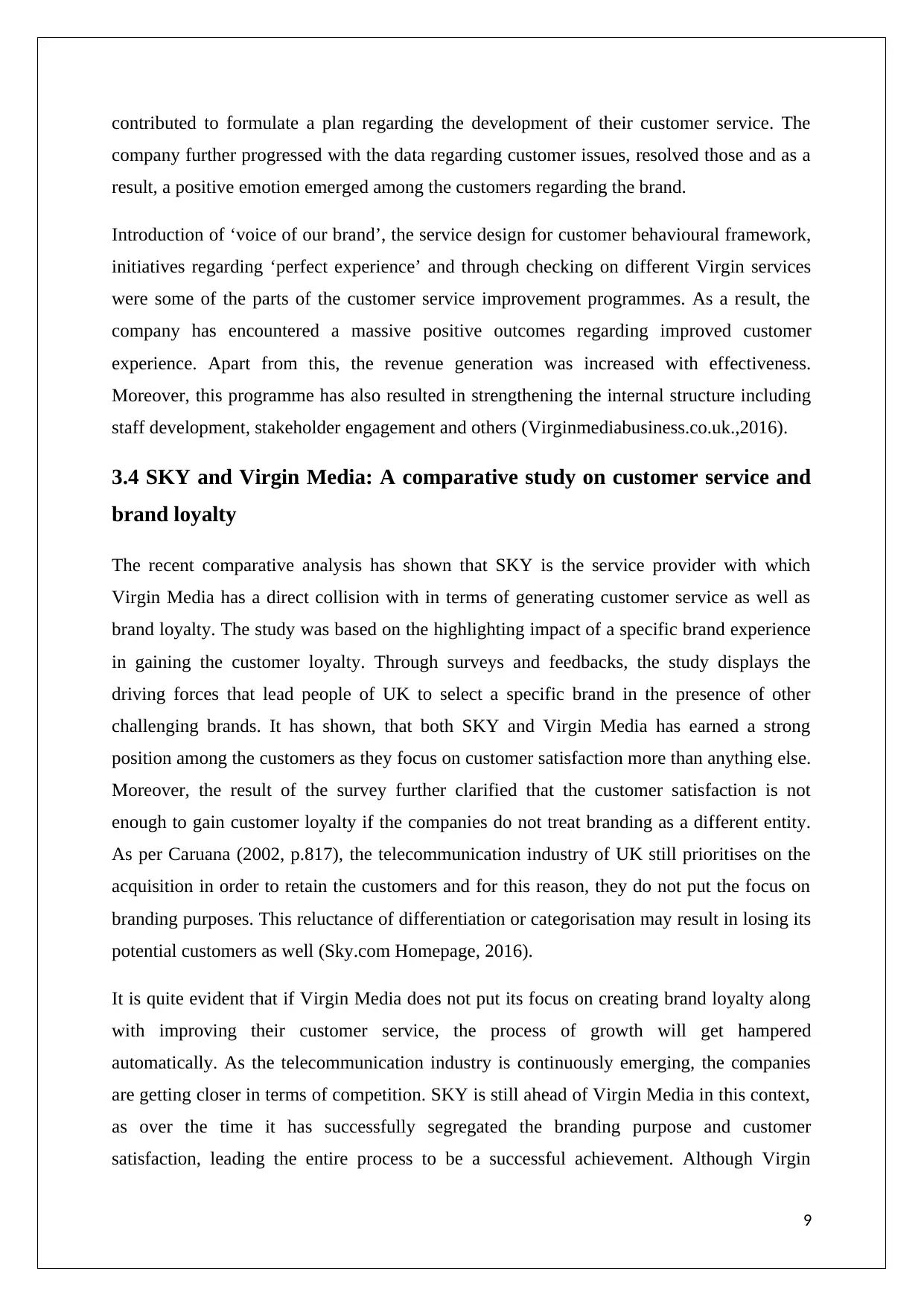
contributed to formulate a plan regarding the development of their customer service. The
company further progressed with the data regarding customer issues, resolved those and as a
result, a positive emotion emerged among the customers regarding the brand.
Introduction of ‘voice of our brand’, the service design for customer behavioural framework,
initiatives regarding ‘perfect experience’ and through checking on different Virgin services
were some of the parts of the customer service improvement programmes. As a result, the
company has encountered a massive positive outcomes regarding improved customer
experience. Apart from this, the revenue generation was increased with effectiveness.
Moreover, this programme has also resulted in strengthening the internal structure including
staff development, stakeholder engagement and others (Virginmediabusiness.co.uk.,2016).
3.4 SKY and Virgin Media: A comparative study on customer service and
brand loyalty
The recent comparative analysis has shown that SKY is the service provider with which
Virgin Media has a direct collision with in terms of generating customer service as well as
brand loyalty. The study was based on the highlighting impact of a specific brand experience
in gaining the customer loyalty. Through surveys and feedbacks, the study displays the
driving forces that lead people of UK to select a specific brand in the presence of other
challenging brands. It has shown, that both SKY and Virgin Media has earned a strong
position among the customers as they focus on customer satisfaction more than anything else.
Moreover, the result of the survey further clarified that the customer satisfaction is not
enough to gain customer loyalty if the companies do not treat branding as a different entity.
As per Caruana (2002, p.817), the telecommunication industry of UK still prioritises on the
acquisition in order to retain the customers and for this reason, they do not put the focus on
branding purposes. This reluctance of differentiation or categorisation may result in losing its
potential customers as well (Sky.com Homepage, 2016).
It is quite evident that if Virgin Media does not put its focus on creating brand loyalty along
with improving their customer service, the process of growth will get hampered
automatically. As the telecommunication industry is continuously emerging, the companies
are getting closer in terms of competition. SKY is still ahead of Virgin Media in this context,
as over the time it has successfully segregated the branding purpose and customer
satisfaction, leading the entire process to be a successful achievement. Although Virgin
9
company further progressed with the data regarding customer issues, resolved those and as a
result, a positive emotion emerged among the customers regarding the brand.
Introduction of ‘voice of our brand’, the service design for customer behavioural framework,
initiatives regarding ‘perfect experience’ and through checking on different Virgin services
were some of the parts of the customer service improvement programmes. As a result, the
company has encountered a massive positive outcomes regarding improved customer
experience. Apart from this, the revenue generation was increased with effectiveness.
Moreover, this programme has also resulted in strengthening the internal structure including
staff development, stakeholder engagement and others (Virginmediabusiness.co.uk.,2016).
3.4 SKY and Virgin Media: A comparative study on customer service and
brand loyalty
The recent comparative analysis has shown that SKY is the service provider with which
Virgin Media has a direct collision with in terms of generating customer service as well as
brand loyalty. The study was based on the highlighting impact of a specific brand experience
in gaining the customer loyalty. Through surveys and feedbacks, the study displays the
driving forces that lead people of UK to select a specific brand in the presence of other
challenging brands. It has shown, that both SKY and Virgin Media has earned a strong
position among the customers as they focus on customer satisfaction more than anything else.
Moreover, the result of the survey further clarified that the customer satisfaction is not
enough to gain customer loyalty if the companies do not treat branding as a different entity.
As per Caruana (2002, p.817), the telecommunication industry of UK still prioritises on the
acquisition in order to retain the customers and for this reason, they do not put the focus on
branding purposes. This reluctance of differentiation or categorisation may result in losing its
potential customers as well (Sky.com Homepage, 2016).
It is quite evident that if Virgin Media does not put its focus on creating brand loyalty along
with improving their customer service, the process of growth will get hampered
automatically. As the telecommunication industry is continuously emerging, the companies
are getting closer in terms of competition. SKY is still ahead of Virgin Media in this context,
as over the time it has successfully segregated the branding purpose and customer
satisfaction, leading the entire process to be a successful achievement. Although Virgin
9
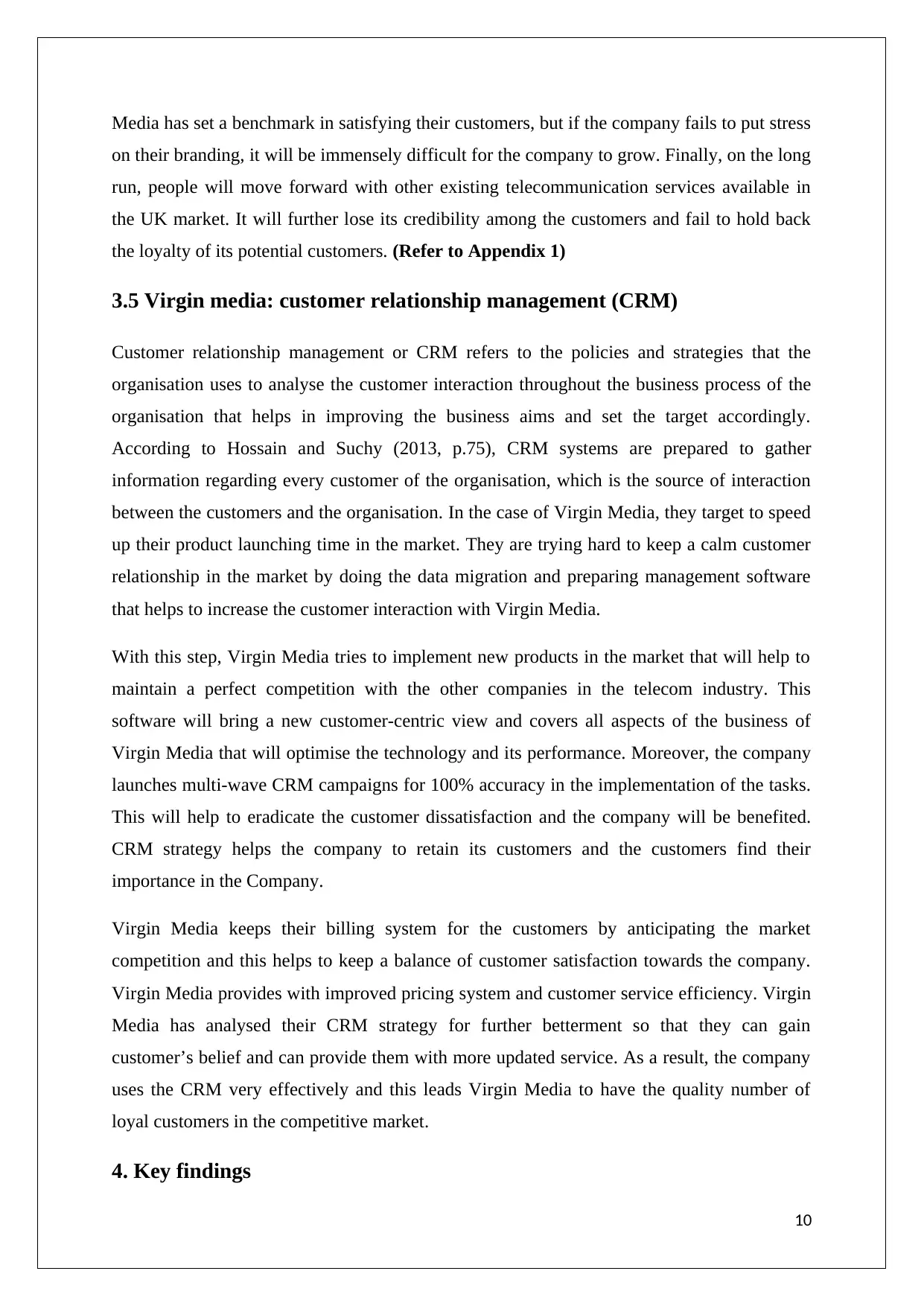
Media has set a benchmark in satisfying their customers, but if the company fails to put stress
on their branding, it will be immensely difficult for the company to grow. Finally, on the long
run, people will move forward with other existing telecommunication services available in
the UK market. It will further lose its credibility among the customers and fail to hold back
the loyalty of its potential customers. (Refer to Appendix 1)
3.5 Virgin media: customer relationship management (CRM)
Customer relationship management or CRM refers to the policies and strategies that the
organisation uses to analyse the customer interaction throughout the business process of the
organisation that helps in improving the business aims and set the target accordingly.
According to Hossain and Suchy (2013, p.75), CRM systems are prepared to gather
information regarding every customer of the organisation, which is the source of interaction
between the customers and the organisation. In the case of Virgin Media, they target to speed
up their product launching time in the market. They are trying hard to keep a calm customer
relationship in the market by doing the data migration and preparing management software
that helps to increase the customer interaction with Virgin Media.
With this step, Virgin Media tries to implement new products in the market that will help to
maintain a perfect competition with the other companies in the telecom industry. This
software will bring a new customer-centric view and covers all aspects of the business of
Virgin Media that will optimise the technology and its performance. Moreover, the company
launches multi-wave CRM campaigns for 100% accuracy in the implementation of the tasks.
This will help to eradicate the customer dissatisfaction and the company will be benefited.
CRM strategy helps the company to retain its customers and the customers find their
importance in the Company.
Virgin Media keeps their billing system for the customers by anticipating the market
competition and this helps to keep a balance of customer satisfaction towards the company.
Virgin Media provides with improved pricing system and customer service efficiency. Virgin
Media has analysed their CRM strategy for further betterment so that they can gain
customer’s belief and can provide them with more updated service. As a result, the company
uses the CRM very effectively and this leads Virgin Media to have the quality number of
loyal customers in the competitive market.
4. Key findings
10
on their branding, it will be immensely difficult for the company to grow. Finally, on the long
run, people will move forward with other existing telecommunication services available in
the UK market. It will further lose its credibility among the customers and fail to hold back
the loyalty of its potential customers. (Refer to Appendix 1)
3.5 Virgin media: customer relationship management (CRM)
Customer relationship management or CRM refers to the policies and strategies that the
organisation uses to analyse the customer interaction throughout the business process of the
organisation that helps in improving the business aims and set the target accordingly.
According to Hossain and Suchy (2013, p.75), CRM systems are prepared to gather
information regarding every customer of the organisation, which is the source of interaction
between the customers and the organisation. In the case of Virgin Media, they target to speed
up their product launching time in the market. They are trying hard to keep a calm customer
relationship in the market by doing the data migration and preparing management software
that helps to increase the customer interaction with Virgin Media.
With this step, Virgin Media tries to implement new products in the market that will help to
maintain a perfect competition with the other companies in the telecom industry. This
software will bring a new customer-centric view and covers all aspects of the business of
Virgin Media that will optimise the technology and its performance. Moreover, the company
launches multi-wave CRM campaigns for 100% accuracy in the implementation of the tasks.
This will help to eradicate the customer dissatisfaction and the company will be benefited.
CRM strategy helps the company to retain its customers and the customers find their
importance in the Company.
Virgin Media keeps their billing system for the customers by anticipating the market
competition and this helps to keep a balance of customer satisfaction towards the company.
Virgin Media provides with improved pricing system and customer service efficiency. Virgin
Media has analysed their CRM strategy for further betterment so that they can gain
customer’s belief and can provide them with more updated service. As a result, the company
uses the CRM very effectively and this leads Virgin Media to have the quality number of
loyal customers in the competitive market.
4. Key findings
10
Secure Best Marks with AI Grader
Need help grading? Try our AI Grader for instant feedback on your assignments.
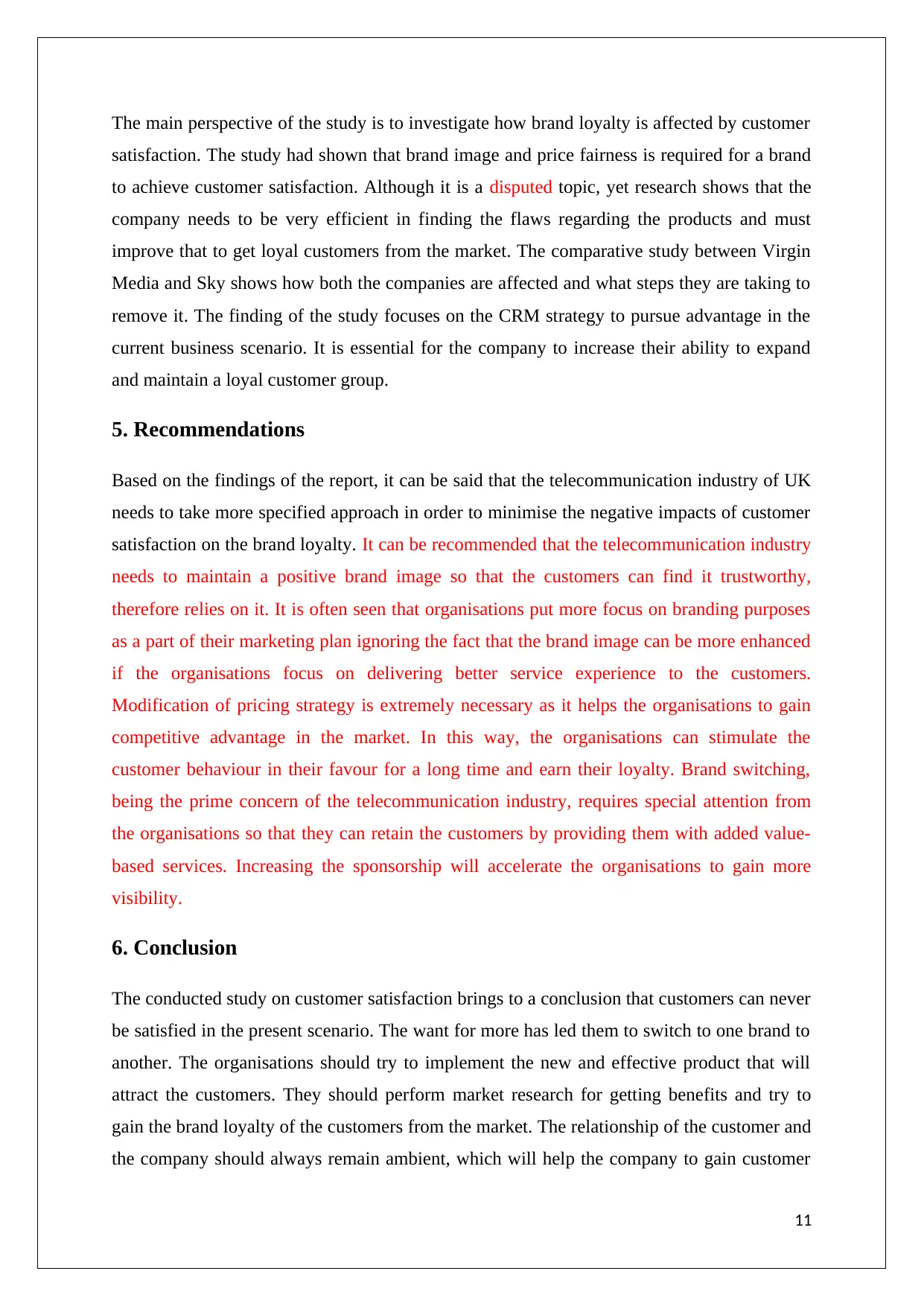
The main perspective of the study is to investigate how brand loyalty is affected by customer
satisfaction. The study had shown that brand image and price fairness is required for a brand
to achieve customer satisfaction. Although it is a disputed topic, yet research shows that the
company needs to be very efficient in finding the flaws regarding the products and must
improve that to get loyal customers from the market. The comparative study between Virgin
Media and Sky shows how both the companies are affected and what steps they are taking to
remove it. The finding of the study focuses on the CRM strategy to pursue advantage in the
current business scenario. It is essential for the company to increase their ability to expand
and maintain a loyal customer group.
5. Recommendations
Based on the findings of the report, it can be said that the telecommunication industry of UK
needs to take more specified approach in order to minimise the negative impacts of customer
satisfaction on the brand loyalty. It can be recommended that the telecommunication industry
needs to maintain a positive brand image so that the customers can find it trustworthy,
therefore relies on it. It is often seen that organisations put more focus on branding purposes
as a part of their marketing plan ignoring the fact that the brand image can be more enhanced
if the organisations focus on delivering better service experience to the customers.
Modification of pricing strategy is extremely necessary as it helps the organisations to gain
competitive advantage in the market. In this way, the organisations can stimulate the
customer behaviour in their favour for a long time and earn their loyalty. Brand switching,
being the prime concern of the telecommunication industry, requires special attention from
the organisations so that they can retain the customers by providing them with added value-
based services. Increasing the sponsorship will accelerate the organisations to gain more
visibility.
6. Conclusion
The conducted study on customer satisfaction brings to a conclusion that customers can never
be satisfied in the present scenario. The want for more has led them to switch to one brand to
another. The organisations should try to implement the new and effective product that will
attract the customers. They should perform market research for getting benefits and try to
gain the brand loyalty of the customers from the market. The relationship of the customer and
the company should always remain ambient, which will help the company to gain customer
11
satisfaction. The study had shown that brand image and price fairness is required for a brand
to achieve customer satisfaction. Although it is a disputed topic, yet research shows that the
company needs to be very efficient in finding the flaws regarding the products and must
improve that to get loyal customers from the market. The comparative study between Virgin
Media and Sky shows how both the companies are affected and what steps they are taking to
remove it. The finding of the study focuses on the CRM strategy to pursue advantage in the
current business scenario. It is essential for the company to increase their ability to expand
and maintain a loyal customer group.
5. Recommendations
Based on the findings of the report, it can be said that the telecommunication industry of UK
needs to take more specified approach in order to minimise the negative impacts of customer
satisfaction on the brand loyalty. It can be recommended that the telecommunication industry
needs to maintain a positive brand image so that the customers can find it trustworthy,
therefore relies on it. It is often seen that organisations put more focus on branding purposes
as a part of their marketing plan ignoring the fact that the brand image can be more enhanced
if the organisations focus on delivering better service experience to the customers.
Modification of pricing strategy is extremely necessary as it helps the organisations to gain
competitive advantage in the market. In this way, the organisations can stimulate the
customer behaviour in their favour for a long time and earn their loyalty. Brand switching,
being the prime concern of the telecommunication industry, requires special attention from
the organisations so that they can retain the customers by providing them with added value-
based services. Increasing the sponsorship will accelerate the organisations to gain more
visibility.
6. Conclusion
The conducted study on customer satisfaction brings to a conclusion that customers can never
be satisfied in the present scenario. The want for more has led them to switch to one brand to
another. The organisations should try to implement the new and effective product that will
attract the customers. They should perform market research for getting benefits and try to
gain the brand loyalty of the customers from the market. The relationship of the customer and
the company should always remain ambient, which will help the company to gain customer
11

satisfaction. The CRM strategy should be made more effective by the organisations as it will
help the organisations for the benefit of the companies.
12
help the organisations for the benefit of the companies.
12
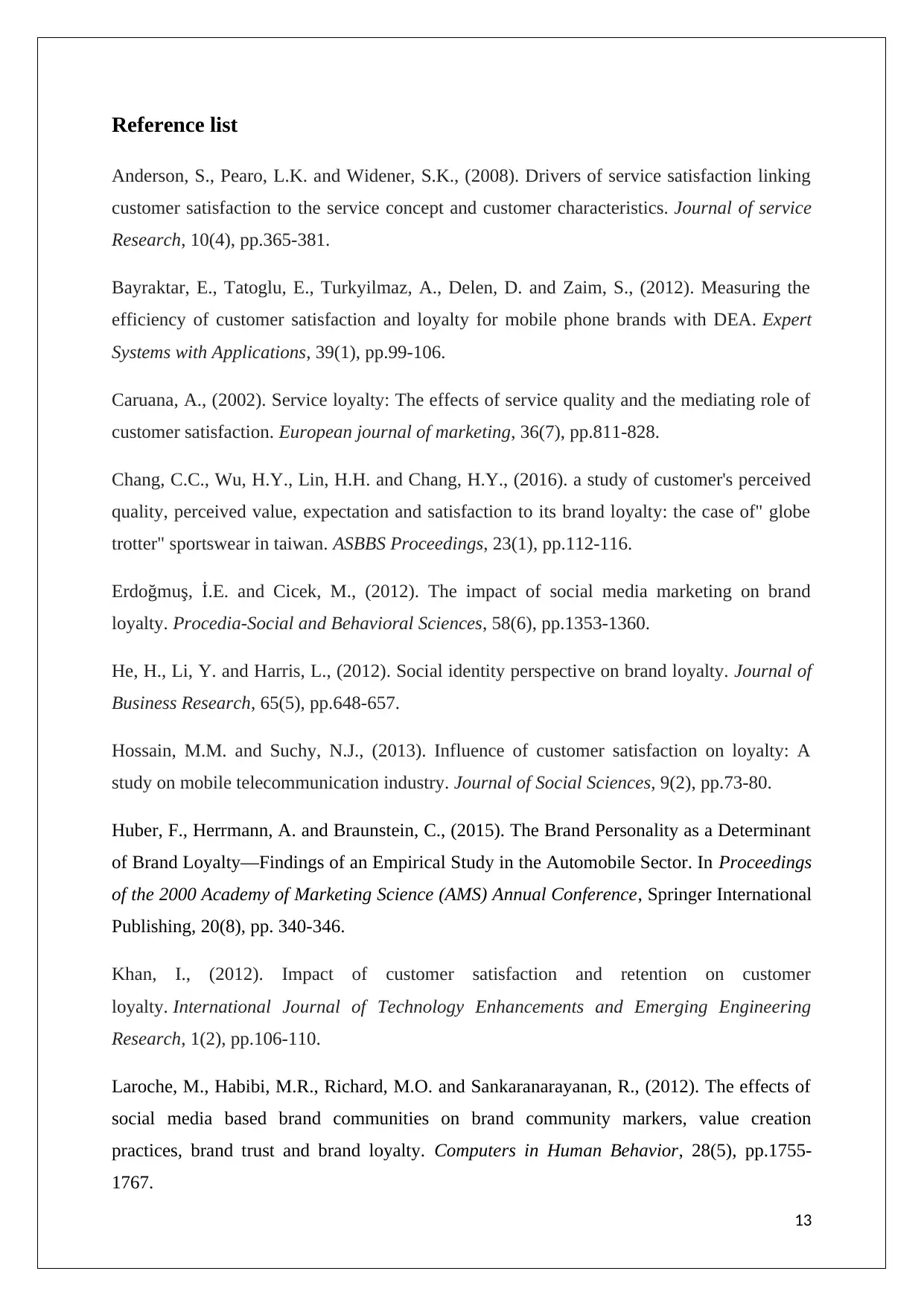
Reference list
Anderson, S., Pearo, L.K. and Widener, S.K., (2008). Drivers of service satisfaction linking
customer satisfaction to the service concept and customer characteristics. Journal of service
Research, 10(4), pp.365-381.
Bayraktar, E., Tatoglu, E., Turkyilmaz, A., Delen, D. and Zaim, S., (2012). Measuring the
efficiency of customer satisfaction and loyalty for mobile phone brands with DEA. Expert
Systems with Applications, 39(1), pp.99-106.
Caruana, A., (2002). Service loyalty: The effects of service quality and the mediating role of
customer satisfaction. European journal of marketing, 36(7), pp.811-828.
Chang, C.C., Wu, H.Y., Lin, H.H. and Chang, H.Y., (2016). a study of customer's perceived
quality, perceived value, expectation and satisfaction to its brand loyalty: the case of" globe
trotter" sportswear in taiwan. ASBBS Proceedings, 23(1), pp.112-116.
Erdoğmuş, İ.E. and Cicek, M., (2012). The impact of social media marketing on brand
loyalty. Procedia-Social and Behavioral Sciences, 58(6), pp.1353-1360.
He, H., Li, Y. and Harris, L., (2012). Social identity perspective on brand loyalty. Journal of
Business Research, 65(5), pp.648-657.
Hossain, M.M. and Suchy, N.J., (2013). Influence of customer satisfaction on loyalty: A
study on mobile telecommunication industry. Journal of Social Sciences, 9(2), pp.73-80.
Huber, F., Herrmann, A. and Braunstein, C., (2015). The Brand Personality as a Determinant
of Brand Loyalty—Findings of an Empirical Study in the Automobile Sector. In Proceedings
of the 2000 Academy of Marketing Science (AMS) Annual Conference, Springer International
Publishing, 20(8), pp. 340-346.
Khan, I., (2012). Impact of customer satisfaction and retention on customer
loyalty. International Journal of Technology Enhancements and Emerging Engineering
Research, 1(2), pp.106-110.
Laroche, M., Habibi, M.R., Richard, M.O. and Sankaranarayanan, R., (2012). The effects of
social media based brand communities on brand community markers, value creation
practices, brand trust and brand loyalty. Computers in Human Behavior, 28(5), pp.1755-
1767.
13
Anderson, S., Pearo, L.K. and Widener, S.K., (2008). Drivers of service satisfaction linking
customer satisfaction to the service concept and customer characteristics. Journal of service
Research, 10(4), pp.365-381.
Bayraktar, E., Tatoglu, E., Turkyilmaz, A., Delen, D. and Zaim, S., (2012). Measuring the
efficiency of customer satisfaction and loyalty for mobile phone brands with DEA. Expert
Systems with Applications, 39(1), pp.99-106.
Caruana, A., (2002). Service loyalty: The effects of service quality and the mediating role of
customer satisfaction. European journal of marketing, 36(7), pp.811-828.
Chang, C.C., Wu, H.Y., Lin, H.H. and Chang, H.Y., (2016). a study of customer's perceived
quality, perceived value, expectation and satisfaction to its brand loyalty: the case of" globe
trotter" sportswear in taiwan. ASBBS Proceedings, 23(1), pp.112-116.
Erdoğmuş, İ.E. and Cicek, M., (2012). The impact of social media marketing on brand
loyalty. Procedia-Social and Behavioral Sciences, 58(6), pp.1353-1360.
He, H., Li, Y. and Harris, L., (2012). Social identity perspective on brand loyalty. Journal of
Business Research, 65(5), pp.648-657.
Hossain, M.M. and Suchy, N.J., (2013). Influence of customer satisfaction on loyalty: A
study on mobile telecommunication industry. Journal of Social Sciences, 9(2), pp.73-80.
Huber, F., Herrmann, A. and Braunstein, C., (2015). The Brand Personality as a Determinant
of Brand Loyalty—Findings of an Empirical Study in the Automobile Sector. In Proceedings
of the 2000 Academy of Marketing Science (AMS) Annual Conference, Springer International
Publishing, 20(8), pp. 340-346.
Khan, I., (2012). Impact of customer satisfaction and retention on customer
loyalty. International Journal of Technology Enhancements and Emerging Engineering
Research, 1(2), pp.106-110.
Laroche, M., Habibi, M.R., Richard, M.O. and Sankaranarayanan, R., (2012). The effects of
social media based brand communities on brand community markers, value creation
practices, brand trust and brand loyalty. Computers in Human Behavior, 28(5), pp.1755-
1767.
13
Paraphrase This Document
Need a fresh take? Get an instant paraphrase of this document with our AI Paraphraser
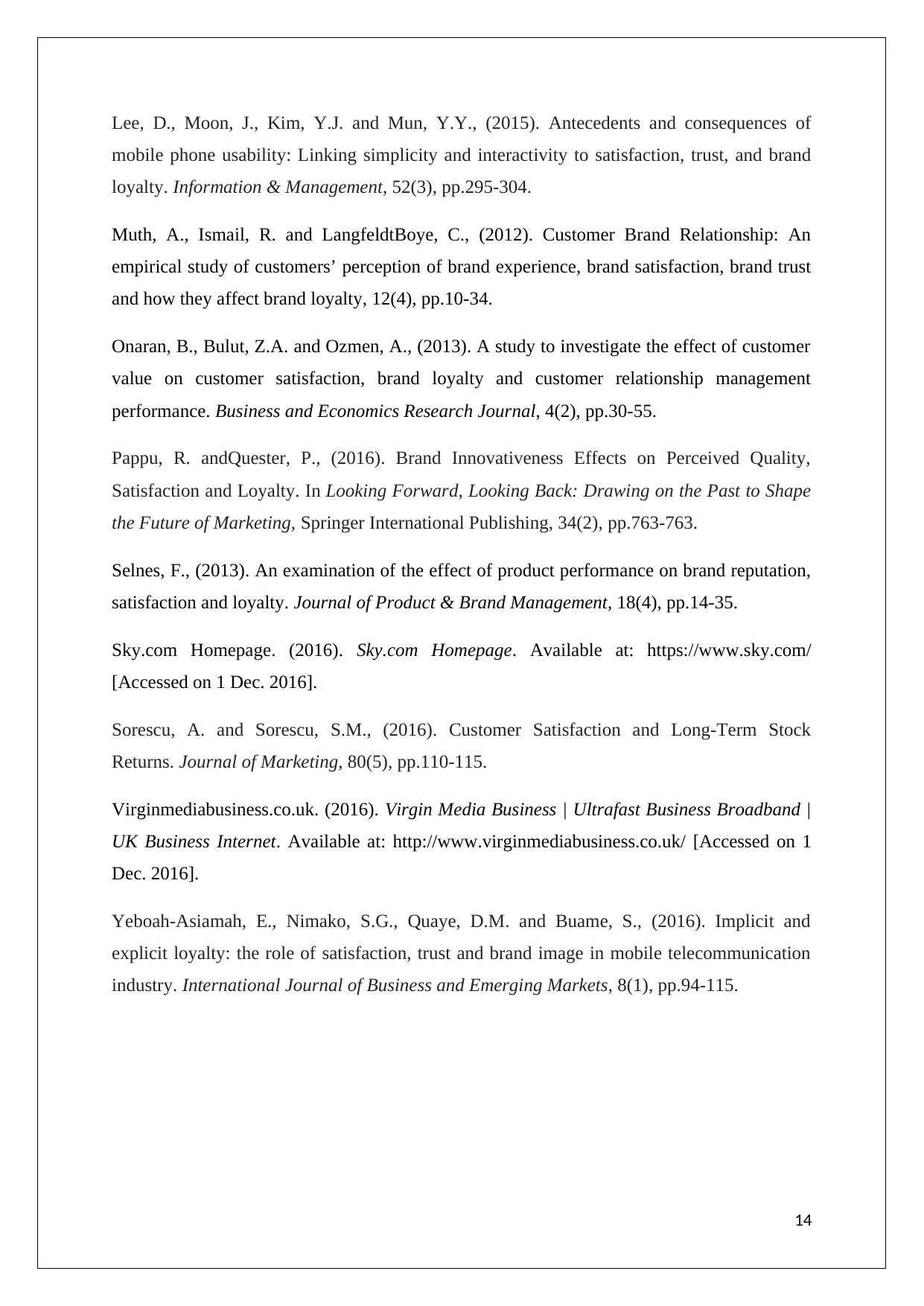
Lee, D., Moon, J., Kim, Y.J. and Mun, Y.Y., (2015). Antecedents and consequences of
mobile phone usability: Linking simplicity and interactivity to satisfaction, trust, and brand
loyalty. Information & Management, 52(3), pp.295-304.
Muth, A., Ismail, R. and LangfeldtBoye, C., (2012). Customer Brand Relationship: An
empirical study of customers’ perception of brand experience, brand satisfaction, brand trust
and how they affect brand loyalty, 12(4), pp.10-34.
Onaran, B., Bulut, Z.A. and Ozmen, A., (2013). A study to investigate the effect of customer
value on customer satisfaction, brand loyalty and customer relationship management
performance. Business and Economics Research Journal, 4(2), pp.30-55.
Pappu, R. andQuester, P., (2016). Brand Innovativeness Effects on Perceived Quality,
Satisfaction and Loyalty. In Looking Forward, Looking Back: Drawing on the Past to Shape
the Future of Marketing, Springer International Publishing, 34(2), pp.763-763.
Selnes, F., (2013). An examination of the effect of product performance on brand reputation,
satisfaction and loyalty. Journal of Product & Brand Management, 18(4), pp.14-35.
Sky.com Homepage. (2016). Sky.com Homepage. Available at: https://www.sky.com/
[Accessed on 1 Dec. 2016].
Sorescu, A. and Sorescu, S.M., (2016). Customer Satisfaction and Long-Term Stock
Returns. Journal of Marketing, 80(5), pp.110-115.
Virginmediabusiness.co.uk. (2016). Virgin Media Business | Ultrafast Business Broadband |
UK Business Internet. Available at: http://www.virginmediabusiness.co.uk/ [Accessed on 1
Dec. 2016].
Yeboah-Asiamah, E., Nimako, S.G., Quaye, D.M. and Buame, S., (2016). Implicit and
explicit loyalty: the role of satisfaction, trust and brand image in mobile telecommunication
industry. International Journal of Business and Emerging Markets, 8(1), pp.94-115.
14
mobile phone usability: Linking simplicity and interactivity to satisfaction, trust, and brand
loyalty. Information & Management, 52(3), pp.295-304.
Muth, A., Ismail, R. and LangfeldtBoye, C., (2012). Customer Brand Relationship: An
empirical study of customers’ perception of brand experience, brand satisfaction, brand trust
and how they affect brand loyalty, 12(4), pp.10-34.
Onaran, B., Bulut, Z.A. and Ozmen, A., (2013). A study to investigate the effect of customer
value on customer satisfaction, brand loyalty and customer relationship management
performance. Business and Economics Research Journal, 4(2), pp.30-55.
Pappu, R. andQuester, P., (2016). Brand Innovativeness Effects on Perceived Quality,
Satisfaction and Loyalty. In Looking Forward, Looking Back: Drawing on the Past to Shape
the Future of Marketing, Springer International Publishing, 34(2), pp.763-763.
Selnes, F., (2013). An examination of the effect of product performance on brand reputation,
satisfaction and loyalty. Journal of Product & Brand Management, 18(4), pp.14-35.
Sky.com Homepage. (2016). Sky.com Homepage. Available at: https://www.sky.com/
[Accessed on 1 Dec. 2016].
Sorescu, A. and Sorescu, S.M., (2016). Customer Satisfaction and Long-Term Stock
Returns. Journal of Marketing, 80(5), pp.110-115.
Virginmediabusiness.co.uk. (2016). Virgin Media Business | Ultrafast Business Broadband |
UK Business Internet. Available at: http://www.virginmediabusiness.co.uk/ [Accessed on 1
Dec. 2016].
Yeboah-Asiamah, E., Nimako, S.G., Quaye, D.M. and Buame, S., (2016). Implicit and
explicit loyalty: the role of satisfaction, trust and brand image in mobile telecommunication
industry. International Journal of Business and Emerging Markets, 8(1), pp.94-115.
14
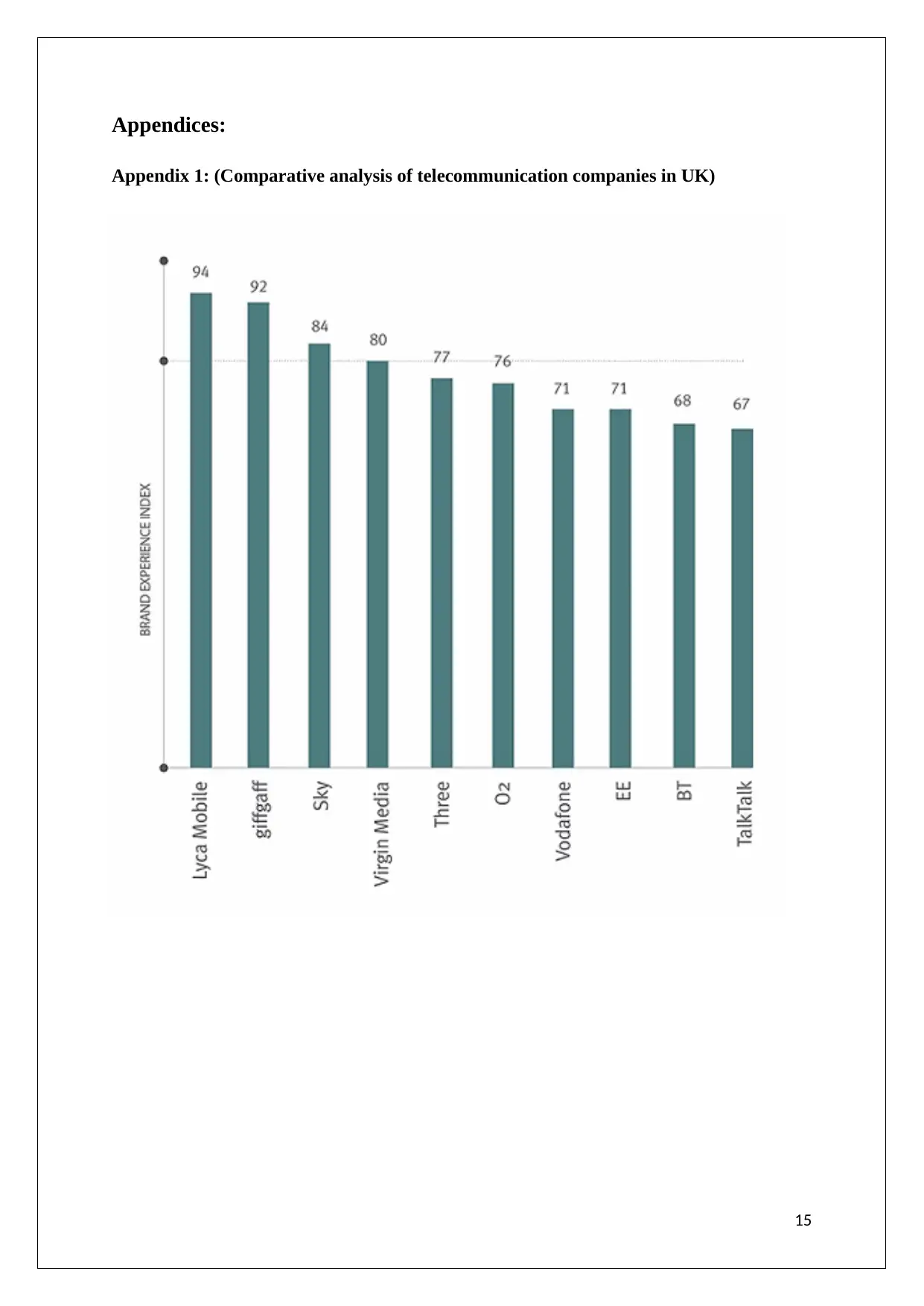
Appendices:
Appendix 1: (Comparative analysis of telecommunication companies in UK)
15
Appendix 1: (Comparative analysis of telecommunication companies in UK)
15
1 out of 15
Related Documents
Your All-in-One AI-Powered Toolkit for Academic Success.
+13062052269
info@desklib.com
Available 24*7 on WhatsApp / Email
![[object Object]](/_next/static/media/star-bottom.7253800d.svg)
Unlock your academic potential
© 2024 | Zucol Services PVT LTD | All rights reserved.





